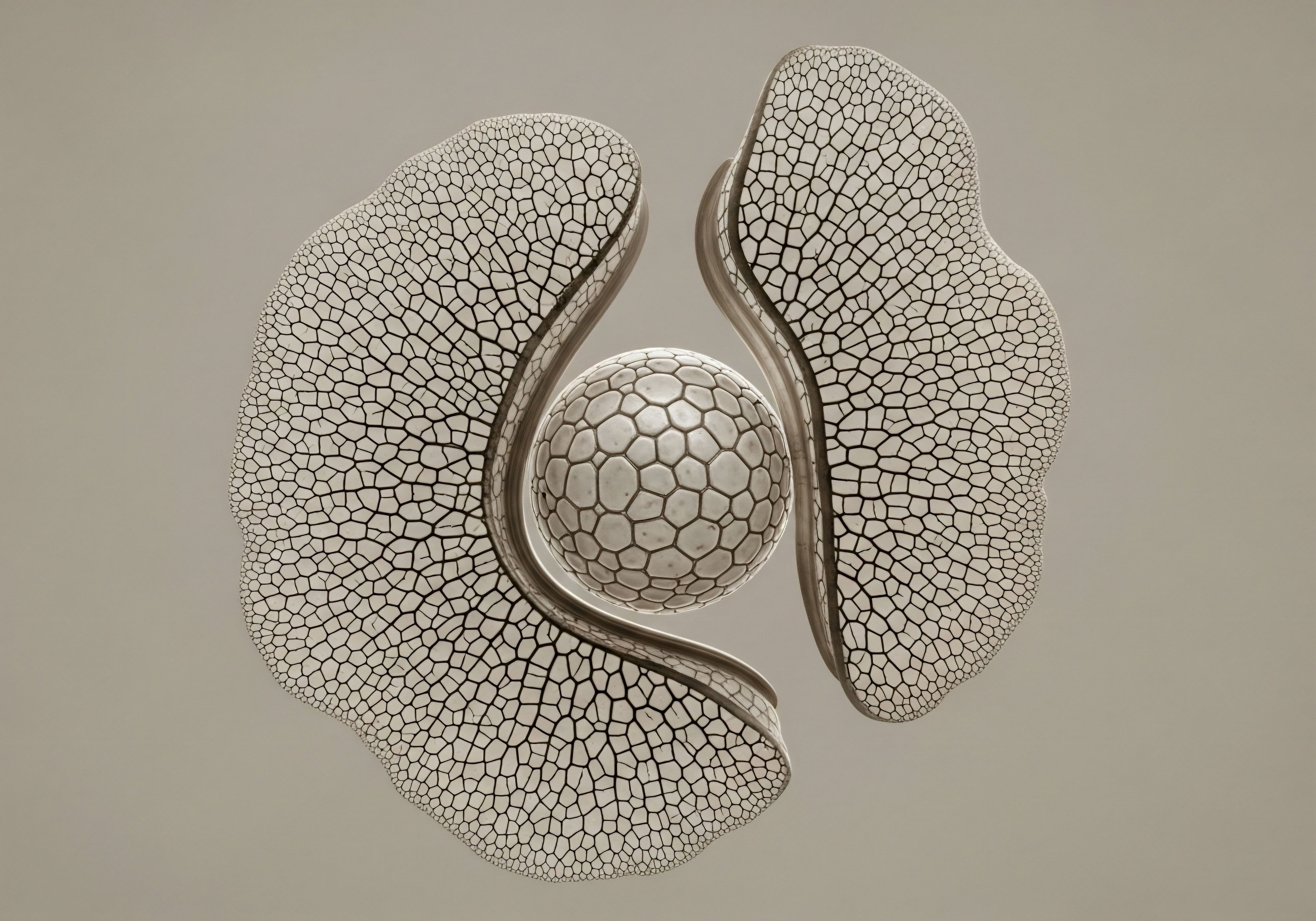

The Signal Decay
Your biology is a conversation. A constant, high-speed data stream between glands and organs, orchestrated by the chemical messengers known as hormones. This is your endocrine system ∞ the master control network that dictates drive, mood, metabolism, and recovery. In your prime, this network is a flawless symphony of command and response.
The signals are clean, the feedback loops are tight, and the result is peak vitality. With time, however, signal decay begins. This is the slow fade of your endocrine edge.
The process is subtle, a gradual degradation of the signal-to-noise ratio in your body’s most critical communications network. The hypothalamus, the system’s command center, begins to issue less forceful directives. The pituitary, the master gland, may struggle to relay those commands with the same authority.
And the gonads, the primary producers of powerhouse hormones like testosterone, respond with diminishing output. This is the biological reality of aging, a process that many accept as inevitable. But acceptance is a choice, not a mandate.

The Domino Effect of Hormonal Decline
A dip in a single key hormone initiates a cascade. Lowered testosterone, for example, does more than blunt libido and soften muscle. It fundamentally alters the body’s metabolic strategy, encouraging fat storage, particularly visceral fat. It impairs insulin sensitivity, setting the stage for metabolic dysfunction.
Cognitive sharpness dulls, motivation wanes, and the intrinsic drive to compete and conquer is replaced by a pervasive sense of fatigue. This is your body shifting from a state of anabolic growth and repair to a catabolic state of managed decline.
The natural decline in key hormones, including estrogen and testosterone, is a primary catalyst for a myriad of aging-related symptoms, from decreased bone density to cognitive shifts.
Reclaiming your endocrine edge means intervening in this process with intention and precision. It is about refusing to let signal decay dictate the terms of your life. It involves using advanced diagnostics to map your unique hormonal signature and deploying targeted therapies to restore the clean, powerful signaling of your youth. This is a strategic recalibration of your internal operating system.


Recalibrating the Human Operating System
Optimizing the endocrine system is a process of systematic engineering. It begins with a comprehensive diagnostic audit to identify the precise points of failure in your hormonal signaling pathways. This is followed by the deployment of targeted, bio-identical inputs and signaling molecules to restore the system’s integrity and performance.

Phase One the Diagnostic Deep Dive
The first step is to acquire high-resolution data on your internal chemistry. A standard blood panel is insufficient. A true vitality architect examines the entire system, mapping the interplay between key hormones and their associated biomarkers. This provides a complete picture of your endocrine status.
- Primary Hormones: Total and Free Testosterone, Estradiol (E2), DHEA-S. These are the foundational pillars of vitality, governing everything from muscle synthesis to mood.
- Pituitary Signaling: Luteinizing Hormone (LH) and Follicle-Stimulating Hormone (FSH). These metrics reveal how effectively your brain is commanding your gonads to produce hormones. Low testosterone with low LH suggests a central, or secondary, issue originating in the pituitary or hypothalamus.
- Binding Proteins: Sex Hormone-Binding Globulin (SHBG). This protein locks onto testosterone, rendering it inactive. High SHBG can mean that even with adequate total testosterone, your biologically available levels are too low to be effective.
- Metabolic and Thyroid Markers: A full thyroid panel (TSH, Free T3, Free T4) and metabolic markers like Insulin and HbA1c are critical. The endocrine system is interconnected; a sluggish thyroid or poor insulin sensitivity will undermine any hormone optimization protocol.

Phase Two the Therapeutic Toolkit
With a clear map of your hormonal landscape, the intervention can begin. The modern toolkit for endocrine optimization is precise and powerful, moving far beyond simple hormone replacement.

Bio-Identical Hormone Replacement Therapy (BHRT)
This is the cornerstone of endocrine reclamation. Unlike synthetic hormones, bio-identical hormones are molecularly identical to those your body produces, ensuring safer and more effective integration into your biology. For men, this typically involves testosterone replacement therapy (TRT) delivered via injection, topical cream, or pellets to restore levels to the optimal range of young adulthood. For women, it involves a nuanced balance of estrogen and progesterone to mitigate the effects of perimenopause and menopause.

Peptide Signaling Agents
Peptides are the next frontier. These short-chain amino acids act as highly specific signaling molecules, instructing your body to perform certain functions with renewed efficiency. They do not replace hormones; they stimulate your body’s own production and enhance cellular communication.
- Sermorelin, CJC-1295, Ipamorelin: These are Growth Hormone Releasing Peptides (GHRPs). They stimulate the pituitary gland to produce more Human Growth Hormone (HGH) in a natural, pulsatile manner. This enhances recovery, improves body composition, and supports cellular regeneration.
- BPC-157: Known for its systemic healing properties, this peptide accelerates tissue repair, reduces inflammation, and improves gut health, creating a more robust internal environment for hormonal balance.


The Timeline of Endocrine Ascendancy
The decision to recalibrate your endocrine system is the decision to stop passively observing your own decline. The process is a strategic engagement with your own biology, and the results unfold over a predictable timeline. The “when” is a function of two things ∞ the moment you decide that your current state is unacceptable, and the biological timeline of adaptation that follows that decision.

The Initial Trigger Points
The catalyst for intervention is rarely a single event. It is a collection of persistent signals that your operating system is running sub-optimally.
- Persistent Fatigue: A feeling of being drained that sleep does not resolve.
- Cognitive Fog: A noticeable drop in mental sharpness, focus, and verbal fluency.
- Physical Stagnation: Diminishing returns in the gym, stubborn body fat accumulation, and a loss of strength or muscle mass.
- Loss of Drive: A marked decrease in ambition, libido, and the general zest for life.
Recognizing these signals is the first step. The next is to initiate the diagnostic deep dive to confirm that these subjective feelings are rooted in objective hormonal data.

The Biological Response Timeline
Once a protocol is initiated, the body begins to respond. This is a phased process of recalibration, with different benefits manifesting at different stages.
By restoring hormonal balance, individuals can experience sustained vitality, improved resilience, and enhanced longevity while reducing the risk of age-related diseases.
The timeline is not instantaneous; it is a progressive build. It requires consistency and patience, with adjustments made based on follow-up lab work and subjective feedback. This is a long-term strategy for sustained peak performance, a commitment to managing your internal chemistry with the same seriousness you apply to your career, your finances, and your most important relationships. It is the definitive step away from passive aging and toward proactive self-mastery.

Your Biology Is a Conversation You Must Lead
The human body is the most sophisticated high-performance machine on the planet. For decades, you benefit from its flawless, autonomous operation. But no system runs at peak capacity forever without intelligent oversight. The slow degradation of your endocrine function is not a moral failing; it is a predictable engineering problem.
The signals weaken, the outputs drop, and the system’s performance declines. Viewing this as an unconquerable tragedy of aging is an outdated paradigm. The superior paradigm is to view your endocrine system as a network that can be monitored, managed, and optimized.
You have the ability to analyze its data, identify its weaknesses, and provide the precise inputs needed to restore its function. This is the ultimate act of taking control of your own hardware. It is the moment you stop being a passenger in your own biology and become the architect of your vitality.



